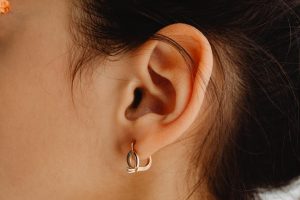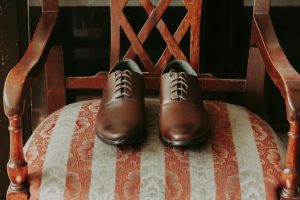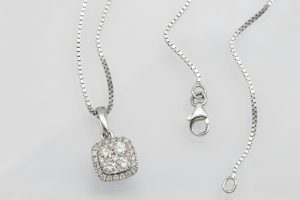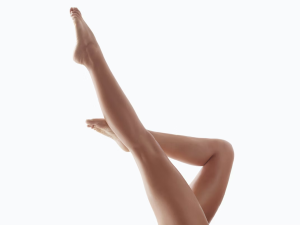Have you noticed Beyoncé, Rihanna, and Kylie Jenner sporting the curated ear, often with a conch piercing? Sophisticated, edgy, and versatile, isn’t it? Where and when did this trend begin? How did it become a part of our culture? And is the after-care routine one should follow? Let’s find out.
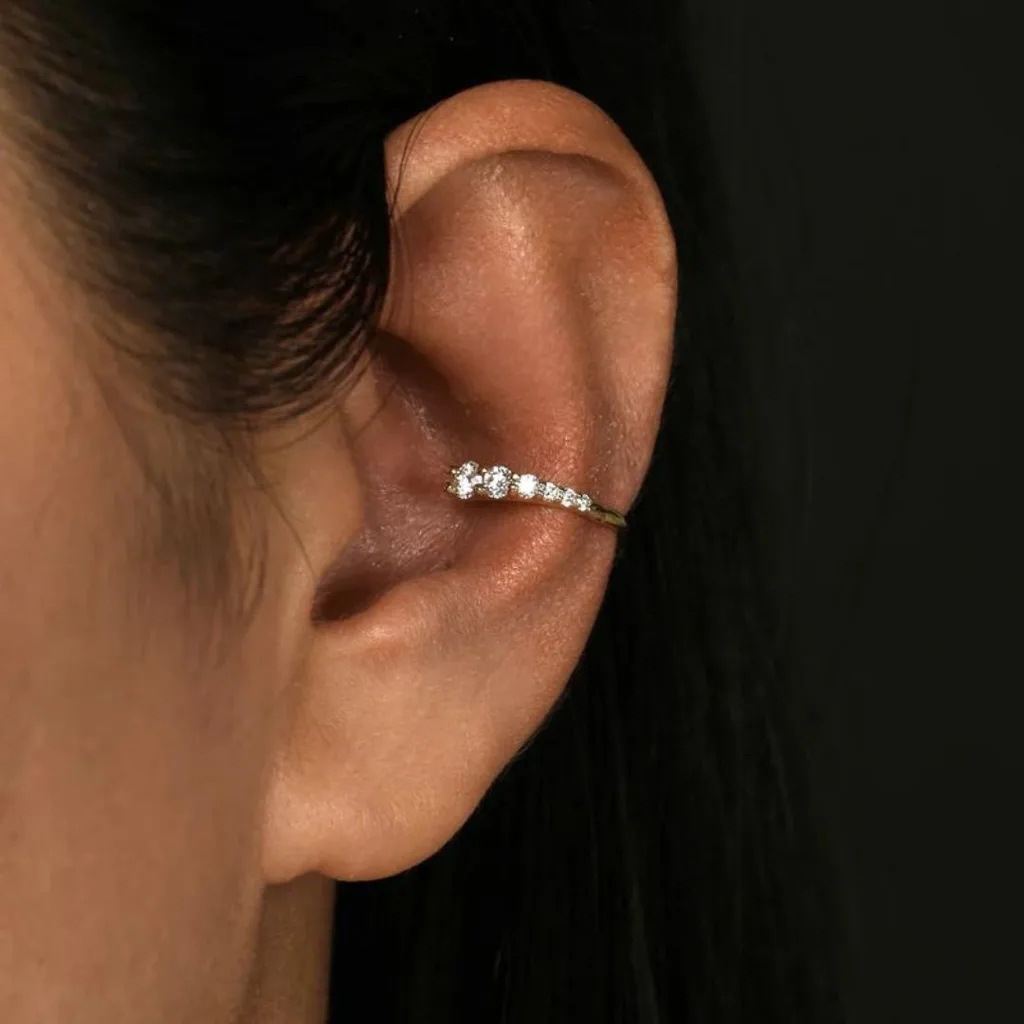
Conch Piercing. Image: Sara And Sebastian
In recent years, body piercings have surged in popularity, evolving from simple adornments to a statement of personal expression. Among the many types, conch piercings have emerged as a distinctive trend, capturing the attention of fashion-forward individuals seeking to make a bold statement. Located in the inner ear, the conch piercing offers a canvas for customization, whether adorned with delicate studs or bold hoops.
The versatility of conch piercings allows wearers to experiment with diverse styles while embracing a vibe of rebellion and individuality. The growing appeal of conch piercings reflects a broader movement towards self-expression in fashion, where body art plays a crucial role in reflecting one’s personality, values, and sense of identity. Whether paired with other ear piercings or worn as a standalone piece, conch piercings have firmly established themselves as a chic, modern trend that is here to stay. Just get pierced with something you want to wear long-term so you aren’t tempted to swap it out early, which is when healing issues happen!
Which begs the question, what are you waiting for? Scroll on to find out everything you need to know about conch piercings, including celebrity looks, expert tips and aftercare.
What is a Conch Piercing?
A conch piercing refers to a body piercing located on the ear, specifically on the inner or outer part of the cartilage of the ear’s bowl. The term ‘conch” is derived from the shape of the ear’s inner cavity, which resembles a seashell. It is one of the most versatile piercings, providing a broad space for jewellery such as studs, hoops, and barbells. The conch piercing can be a bold statement or a subtle addition to a curated ear look, depending on the style and jewellery chosen. Due to its placement within the ear’s structure, it requires careful consideration in terms of healing time and the selection of suitable jewellery.
There are two primary types of conch piercings — the Inner Conch and the Outer Conch. The Inner Conch piercing is located in the centre of the ear’s bowl, near the ear canal. This placement is discreet and is pierced with a small stud or hoop. It is often seen as a more intimate and subtle style of conch piercing. In contrast, the Outer Conch piercing is situated along the outer rim of the ear’s bowl, closer to the ear’s edge. This piercing is visible and tends to be pierced with a hoop or barbell, offering a striking appearance.
If the ear look you desire is one that involves more than one conch piercing, opt for double or triple details, provided the shape of your ear will allow it. However, you would need to decide this before your first piercing to make sure it leaves room for the correct spacing. Experts suggest getting them done one at a time rather than all at once to help the healing process.
History of Conch Piercings
The roots of conch piercings can be traced back to the ancient practice of ear piercing, which has existed for centuries. Ear piercings have been seen as both decorative and symbolic, with early evidence of ear piercings found in ancient Egypt and Mesopotamia, where they were often used to signify social status or spiritual beliefs. These early piercings, however, were usually in the earlobe, whereas the conch piercing—located in the inner or outer area of the ear’s cartilage—became distinct in its own right later.
The origins of the conch piercing specifically are less documented, but it is believed to have originated in ancient civilisations where body modifications were common. In Native American cultures, for instance, ear piercings were used to signify warrior status, spiritual strength, or tribal affiliations. Among some African tribes, ear piercings, including those in the conch area, were used as rites of passage or a symbol of beauty. These piercings often held spiritual significance, and the practice of adorning the body was deeply linked to cultural identity, reinforcing social and religious beliefs. While the conch piercing specifically may not have been a widespread practice in these cultures, the concept of ear piercings has ancient roots.
In addition to their physical beauty, conch piercings have been given cultural meaning in a number of societies. Among the Native American tribes, such as the Navajo, wearing ear adornments like earrings and other forms of piercing was an important ritual for marking maturity, strength, and cultural belonging. In African tribal cultures, body piercings, including those of the ear, were integral to social status, with elaborate piercings denoting a person’s position in the tribe. The conch piercing, as part of this wider tradition, was viewed as a mark of beauty, adulthood, and a connection to ancestral or spiritual realms.
In the late 20th century, body piercings became more common in Western fashion, especially during the 1990s when alternative cultures and subcultures embraced body art. The conch piercing, with its placement in the ear’s cartilage, became a symbol of individuality and rebellion among the youth. It was popularised by celebrities, gaining a strong following in the piercing community. By the early 2000s, conch piercings were no longer limited to countercultural movements and made their way into mainstream trends.
Today, conch piercings are a sought-after style of body piercing, appreciated for their versatility and ability to stand out while complementing various ear adornments. The conch style can be customised with a range of jewellery, from studs to hoops or spirals, which makes it a favourite for those looking to make a personal statement. It is also a popular choice for those seeking to express individuality while respecting the historical and cultural significance of body modification.
Why Choose A Conch Piercing?

Conch Piercing
Conch piercings have become a popular choice for those seeking a unique and stylish look. Positioned in the ear’s inner or outer cartilage, conch piercings can be bold or understated, making them a good choice for individuals who want to make a statement without overdoing it. The piercing’s placement provides space for jewellery, allowing wearers to express their personality. Whether a simple stud or a hoop, conch piercings add an edgy, sophisticated vibe to any look.
Celebrities and influencers have embraced conch piercings. Bella Hadid, for example, has been spotted with multiple ear piercings, including conch piercings, adding a touch of rebellion to her polished style. Kendall Jenner, known for her minimalist chic aesthetic, wears conch piercings. Rihanna has worn conch piercings on several occasions, from casual street style to the red carpet. These style icons have helped make conch piercings a mainstream fashion statement.
One of the key benefits of conch piercings is their versatility when it comes to jewellery. This piercing allows wearers to experiment with a range of jewellery styles, from studs to hoops. The flat surface of the conch provides the perfect backdrop for creative designs, enabling people to showcase a variety of styles, whether they prefer something minimalist or maximalist. Additionally, the ability to layer conch jewelry with other ear piercings offers endless opportunities for personalisation. Conch piercings have also been seen in runway shows and editorials. Leading fashion designers and stylists have added conch piercings, recognising their potential to enhance the overall aesthetic.
The Piercing Process
Before getting a conch piercing, it’s important to take a few preparatory steps to ensure a smooth procedure. Start by choosing a reputable piercing studio that follows strict hygiene standards. Cleanliness is key to avoid infection, as conch piercings are done through the cartilage. It’s advisable to avoid alcohol or blood-thinning medications 24 hours before the piercing, as this can increase the risk of excessive bleeding. When you arrive at the studio, your piercer will typically consult with you about the piercing placement and jewellery options. After cleaning the area and marking the spot, they will prepare for the procedure, ensuring both the environment is clean and sterile.
The conch piercing procedure is straightforward. Once the area is sterilised, the piercer will use a hollow needle to pierce the ear’s cartilage, either through the inner or outer conch. The needle is quick and precise, though you might feel a sharp pinch or pressure. Once the piercing is complete, the piercer will insert a sterile jewellery piece, such as a stud or hoop, and may apply an antiseptic solution. Aftercare is crucial to prevent infection. Clean the area regularly with saline solution and avoid touching or rotating the jewellery.
Most people experience a sharp sensation during the piercing, followed by mild soreness for a few hours. The healing process typically takes a few months. During this period, swelling or tenderness might occur, but this usually subsides after a few days. It’s important to follow aftercare instructions, as improper care can lead to infections or keloid formation. Professional piercers like Maria Tash and Studs Piercing Studio, famous for their modern approach to piercings, ensure that their clients receive detailed instructions on how to maintain the piercing and address any potential issues during the healing process.
Choosing the Right Jewellery for Conch Piercings
When selecting jewellery for conch piercings, it’s essential to consider comfort and style. The best materials are hypoallergenic and durable, such as titanium, niobium, and 14k or 18k gold. These materials are safe for sensitive skin and prevent irritation. Stainless steel is a popular choice due to its strength and versatility. As for styles, the options range from studs and hoops to spirals and cuffs. The right size is crucial—jewellery that is too large or too small can cause discomfort.
Tiffany & Co., known for its luxury and craftsmanship, offers elegant designs that work beautifully with conch piercings. Anatometal, a leader in body jewellery, produces precision-crafted pieces using implant-grade materials, ensuring both aesthetic appeal and safety. Body Vision Los Angeles is another top brand known for creating intricate, high-quality jewellery that fits well with conch piercings. These brands offer a variety of designs, from minimalist styles to elaborate, gemstone-studded pieces, allowing individuals to express their personal style while ensuring their jewellery is of the highest quality.
Aftercare: How to Maintain Your Conch Piercing
Proper cleaning and aftercare are essential for ensuring the conch piercing heals effectively. Start by cleaning the area twice a day using a saline solution or a piercing-safe antimicrobial soap. Use a cotton swab or gauze to gently clean around the piercing, being cautious not to irritate the area. Avoid using alcohol or hydrogen peroxide, as these can damage the tissue. When cleaning, always wash your hands thoroughly to prevent introducing bacteria to the piercing. After cleaning, gently pat the piercing dry with a clean tissue or paper towel, and avoid touching the piercing with dirty hands.
Following specific aftercare instructions is key to a successful healing process. Do sleep on the opposite side of your piercing to avoid putting pressure on it and try not to rotate or twist the jewellery as this can cause irritation. Don’t submerge the piercing in bodies of water like pools, lakes, or hot tubs during the healing period as these environments can introduce bacteria. Avoid changing or removing the jewellery until the piercing is fully healed, which typically takes six months. Lastly, avoid using harsh chemicals, such as peroxide or alcohol, around the piercing as they can irritate the skin.
It’s normal to experience discomfort, swelling, and tenderness after getting a conch piercing. To soothe the discomfort, you can use a cold compress or an ice pack wrapped in a clean cloth and apply it to the area for a few minutes a few times a day. Additionally, elevating your head while sleeping can help reduce swelling. To promote faster healing, ensure you’re eating a nutritious diet rich in vitamins, particularly Vitamin C. Avoid smoking or alcohol, as these can hinder the healing process.
As with any body piercing, there are potential risks associated with a conch piercing, such as infection or the formation of keloids. Infections can occur if bacteria enters the wound, so it’s important to keep the piercing clean. Signs of infection include increased redness, warmth, discharge, or a bad smell. If you notice any of these symptoms, seek medical attention promptly. If a keloid begins to form, consult your piercer or a dermatologist to discuss treatment options, which may include silicone sheets or corticosteroid injections.
Conch Piercings in Pop Culture and Fashion
Conch piercings, which involve the cartilage of the ear, have become a popular statement in pop culture and fashion, often worn by celebrities whose influence brought this bold style into the mainstream. Icons like Rihanna and Kylie Jenner have sported conch piercings, turning them into a must-have accessory to elevate the ear game.
The influence of conch piercings has expanded into the broader fashion scene, with fashion designers and streetwear brands incorporating them into their looks. These piercings symbolise a rebellious albeit sophisticated attitude, offering a way to express individuality while keeping things stylish. As the trend has evolved, conch piercings have gone from being a niche alternative to a mainstream accessory, inspiring fashion enthusiasts to experiment with ear piercings as a form of self-expression.
Conclusion: Is the Conch Piercing Right for You?
In conclusion, the conch piercing offers a unique combination of aesthetic appeal, cultural significance, and style, making it a standout choice for those seeking to express their individuality. With its striking position in the ear and versatility in design, it can be a bold statement piece or a subtle addition to an overall look. Whether for personal expression, cultural ties, or for the love of fashion, the conch piercing allows individuals to experiment with diverse styles and jewellery. Ultimately, it’s about embracing what best represents your personal style and finding the perfect way to showcase your individuality!

Jasmeen Dugal is Associate Editor at FashionABC, contributing her insights on fashion, technology, and sustainability. She brings with herself more than two decades of editorial experience, working for national newspapers and luxury magazines in India.
Jasmeen Dugal has worked with exchange4media as a senior writer contributing articles on the country’s advertising and marketing movements, and then with Condenast India as Net Editor where she helmed Vogue India’s official website in terms of design, layout and daily content. Besides this, she is also an entrepreneur running her own luxury portal, Explosivefashion, which highlights the latest in luxury fashion and hospitality.






